BBC Micro:bit C++ Off-line Setup
by drmpf in Circuits > Microcontrollers
5095 Views, 9 Favorites, 0 Comments
BBC Micro:bit C++ Off-line Setup
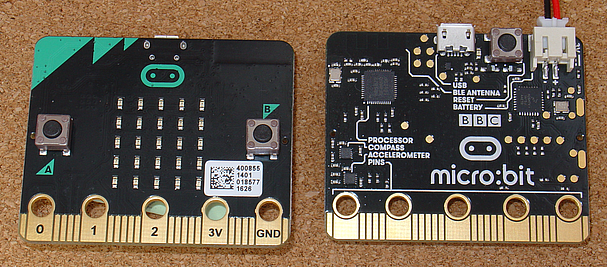
Update: 21st December 2106 – Fixing paring with Pixel
If you are having problems paring with Pixel or other Android 7.1 mobiles, implement the 500mS delay shown in this GitHub pull request #225
Introduction
There are a number of ways to write and compile programs for the BBC micro:bit. This instructable covers setting up an offline compiler and docs that will be used to compile the code generated by pfodDesignerV2 ,when its micro:bit update is available. But this setup can also be used for any C++ micro:bit programming.
These instructions are also available here.
This offline setup does not require any accounts to created and does not require an internet connection once the setup is complete. This tutorial is based on the Offline C/C++ Development With The Micro:bit Using NetBeans article, (also see Getting Started with Offline C++ on the BBC Micro:Bit and BBC micro:bit Yotta for the setting up Yotta part), but it is modified to work with Netbeans 8.1.
It also saves and reuses the downloaded micro:bit support files from project to project. This has two advantages:- i) you avoid downloading ~90Meg of files for each new project
ii) you get a consistent set of support files from project to project (with a consistent set of bugs and limitations)
Here I will be setting up the offline compiler for Windows using Netbeans as the IDE, refer to that article for setting up on Mac and Linux, which are a little easier. It is also possible to use Eclipse as the IDE, but that is not covered here.
I am still waiting on the arrival of my micro:bit boards to test out the board loading.
Installing Netbeans C++ IDE
To download Netbeans IDE for C++ develoment, which is all that is needed here, goto the Netbeans download page and click the download button at the bottom of the C/C++ column, choose either x86 for an 8bit windows version or x64 for a 64bit version depending on your computer. (Try right clicking Computer in the windows explorer and select Properties to see what type of Windows you have).
When the Netbeans download finishes, run the netbeans-8.1-cpp-windows-x64.exe to install it. It will install a Java JRE if needed. The first time I tried to install Netbeans I got an “incompatible JVM” error message, so I uninstalled the previously install JRE's and re-ran the Netbeans exe which worked. On opening Netbeans for the first time I was prompted to update a number of plugins. Restarting Netbeans installed the updates.
Installing Yotta
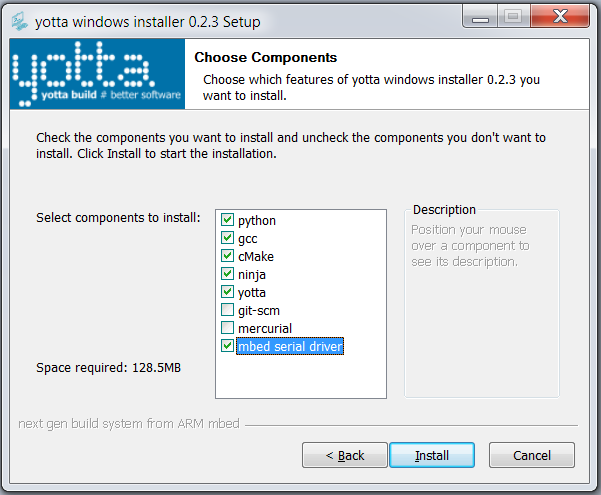
Yotta is the build system used to micro:bit C++ programs. Download the Yotta Installer (yotta_install_v023.exe in my case). Run the exe after it downloads. It installs to C:\yotta
When you get to the Choose Components screen, check the mbed serial drive as well as the ones already ticked. Windows needs a serial driver, Mac OS and Linux do not. You need to have a micro:bit board plugged in in order to install the mbed serial driver.
If you don't have a board yet, just cancel the install you can do it later by running C:\yotta\mbedWinSerial_...exe The latest serial driver is also available from here. See Serial connection via USB below.
There was a note about a pip upgrade, which I ignored. Lots of packages get download during the install, so it may take some time.
micro:bit also need a utility called srecord You can down load the zip file (srecord-1.63-win32.zip) from https://sourceforge.net/projects/srecord/files/srecord-win32/ Then unzip to the yotta directory. Windows explorer will open the zip file and then you can copy and paste all the files to the c:\yotta directory.
Setting Up an Initial Micro:bit Project
There will be a Run Yotta short cut on the desktop (or you can open a command prompt and change directories to the yotta installation directory, c:\yotta (i.e. cd c:\yotta) and run the batch file run_yotta.bat ) This batch file sets the paths correctly to find all of the programs involved in using yotta.
Following the instructions the Offline C/C++ Development With The Micro:bit Using NetBeans article, run yotta and do the following steps to install the micro:bit support needed.
mkdir emptyproject
cd emptyproject
yotta init
Accept the defaults for init except to the question Is this an executable answer yes
Then set the micro:bit target
yotta target bbc-microbit-classic-gcc
Yotta download the gcc compiler.
Then install the microbit support using the cmd
yotta install lancaster-university/microbit
This can take a while to download the support code. Note: You may be prompted to sign up/login to the MBed website to download the code. Just ignore that.
Stop at this point.
Creating a New Project From Your Emptyproject
Using the standard install instructions you would be downloading the lancaster-university/microbit files every time you started a new project. This would require you to be on-line and use up downloads each time. You can avoid this by copying from your emptyproject. (Of course you may want to downloaded the support files every now and again in order to get the latest updates.)
- To create a new project, create a new directory, say pfodtest in the same directory as the emptyproject directory. NOTE: The new directory name MUST start with a lowercase letter followed by lowercase letters or numbers.
- copy all the contents of the emptyproject to the new pfodtest directory.
- In the pfodtest directory, open the module.json file and edit the name: entry to “pfodtest”
{
"name": "pfodtest",
"version": "0.0.0",
"bin": "./source",
"private": true,
"author": "",
"license": "Apache-2.0",
"dependencies": {
"microbit": "^2.0.0-rc4"
}
}To complete the new project setup, create a file, say main.cpp, in the pfodtest/source directory. Note: There in nothing special about the name of main.cpp, you can call this file anything you like.
Finally go back to the yotta cmd window and change directory to your new pfodtest directory and do an initial build
rem move out of emptyproject dir
cd ..
rem then change dir into the new project dir
cd pfodtest
yotta build
Under the C:/ ../pfodtest/build/bbc-microbit-classic-gcc/source directory you will find the pfodtest-combined.hex file which is the one you want to download to your micro:bit
Note the ...-combined.hex file is in the /source sub-directory of …./build/bbc-microbit-classic-gcc
Integration With Netbeans IDE
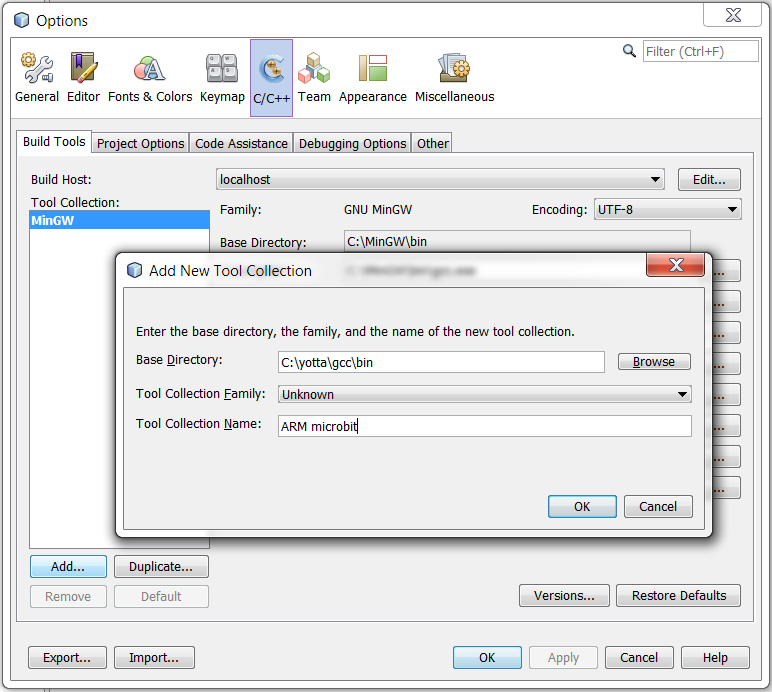
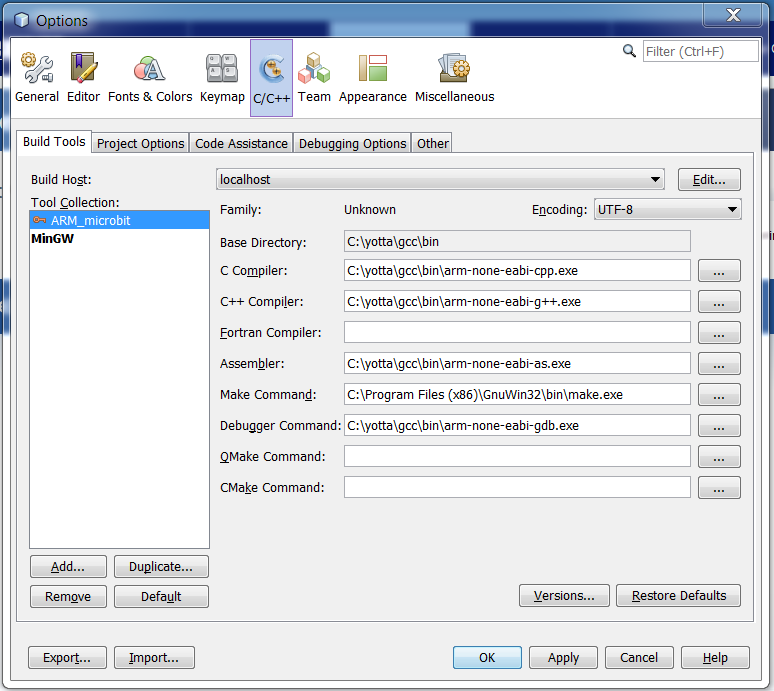
You need only do this step once. Once you have performed this IDE setup, next time you start a new project you can go to Creating a New Project in Netbeans
Now that you have your new project built for the first time using yotta build you can integrate it with Netbeans.
First you need to add the yotta install directory, C:\yotta, to the system path. (Edit system environmental variables) use ; to separate it from the existing paths.
You also need to install nmake for windows from http://gnuwin32.sourceforge.net/packages/make.htm Download the complete package, except sources. Run the downloaded exe, make-3.81.exe to install it.
Add a New Tool Collection
Note: These steps in Netbean 8.1 are a little different from the article.
Open Netbeans and open Tools->Options. Click on the C/C++ tab. Click on the Build Tools tab. Then click the Add.. button
Fill in the base directory as shown. Then select Family as GNW Cygwin, then re-select it back to Unknown. Then enter the tool name ARM microbit
Click OK and then enter the compiler paths as shown.
Then click Apply to save these settings and OK to close.
Creating a New Project in Netbeans
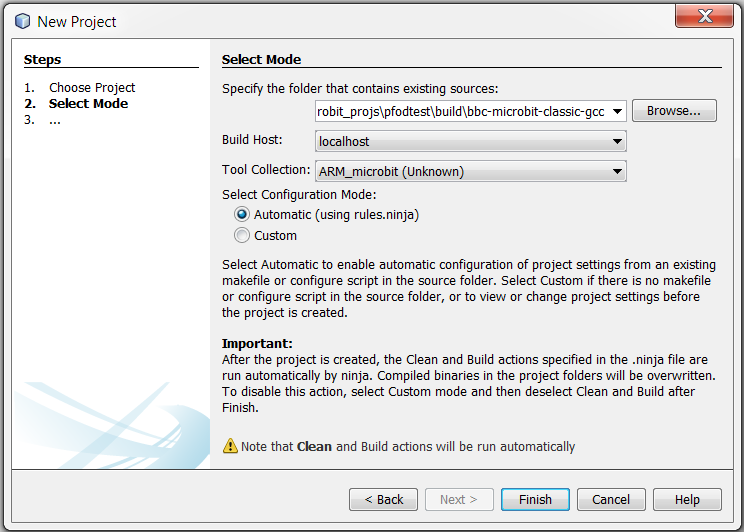
Use File-> New Project and select a C++ project with existing sources.
Then browse to pfodtest\build\bbc-microbit-classic-gcc directory as the folder containing the sources.
NOTE this NOT where you created the main.cpp file, it is the \build\bbc-microbit-classic-gcc directory created by the yotto build command.
Set the Tool Collection to ARM_microbit and click Finish
Netbeans will automatically start a build. You can then open the source main.cpp file and edit it in Netbeans and use netbeans Build (hammer) or Clean and build buttons (hammer and broom) to rebuild the project.
Missing Include files and Unused Parameter warnings.
Netbeans code highlighting will/may show some include files as referencing missing includes. This is a bug in Netbeans. If the project builds and links without errors then all is OK and you can ignore these highlighted includes.
By default, the Netbeans build shows warnings for unused parameters in methods. Event handlers often do not use their MicroBitEvent parameter and this raises a number of warnings. To suppress these warnings, and document that the parameter was not meant to be used, add the UNUSED macro. i.e. at the top of your code file add the define
#define UNUSED(x) (void)(x)
then in the method add
void onConnected(MicroBitEvent e) {
UNUSED(e);Adding More Source Files to Your Project
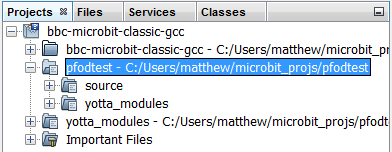
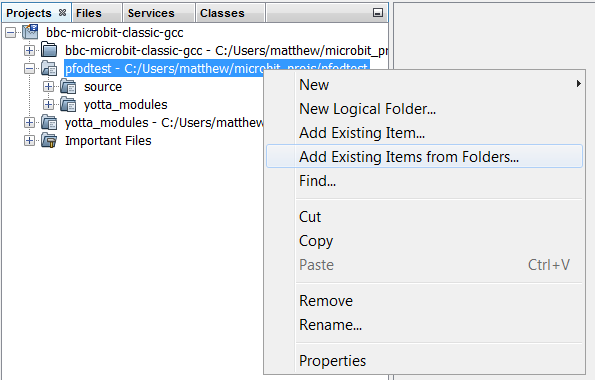
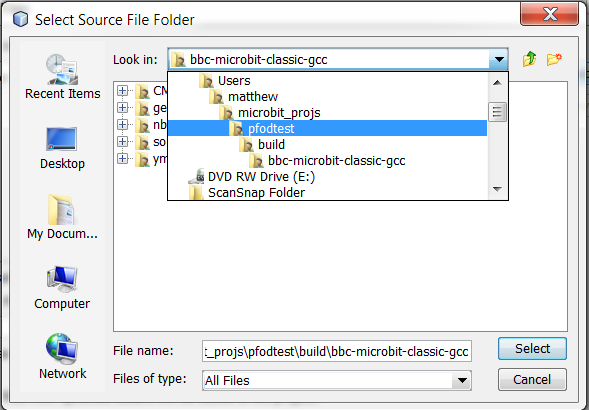
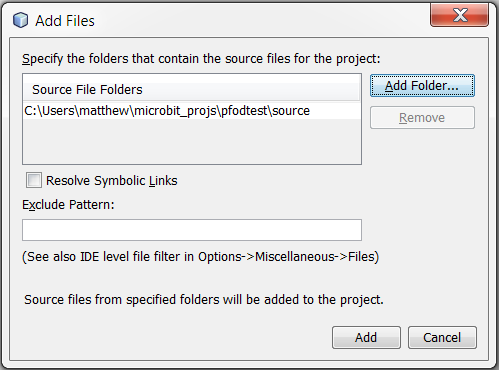
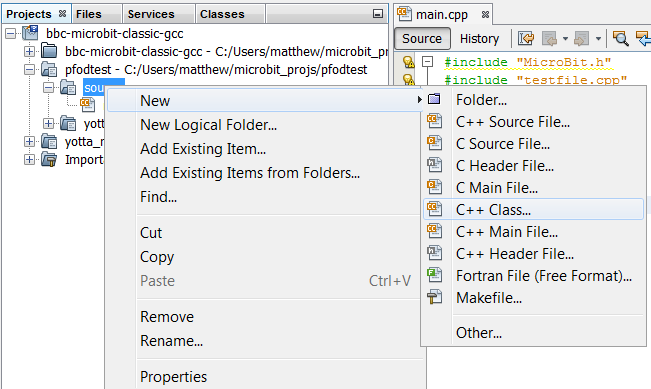
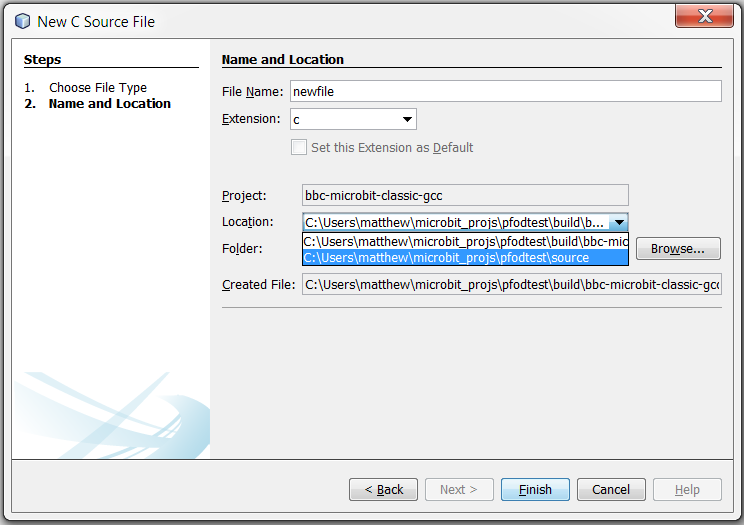
Often you only need one .cpp file, the main.cpp, but if you need add another file DO NOT just use the Netbeans File New-> command because, by default Netbeans will NOT put your new file in the pfodtest/source directory.
Instead you need to first initialize the Netbeans' New File source folders to include your pfodtest/source.
Follow the screen shots above
Navigate to your source folder.
The right click and click on Add Existing Items from Folders..
Navigate up the folder tree to the pfodtest directory.
Then click Add to add that folder. That initializes Netbeans with this directory as a 'source' directory for adding new files.
Now you can use Netbeans File->New File (or right click on the pfodtest/source directory) to add a new file.'
Note: At the Name and Location step, hit the drop down list under Folder: and choose the pfodtest\source dir.
Opening Netbeans Micro:bit Projects -- Project Groups
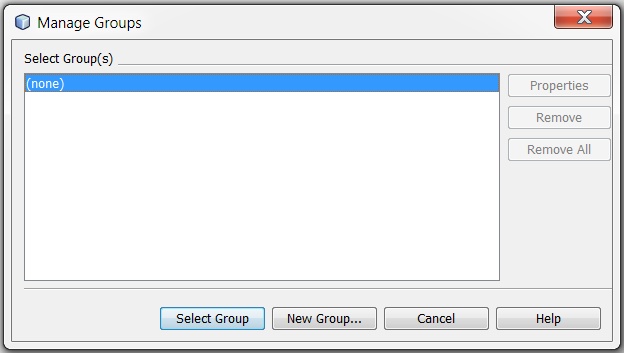
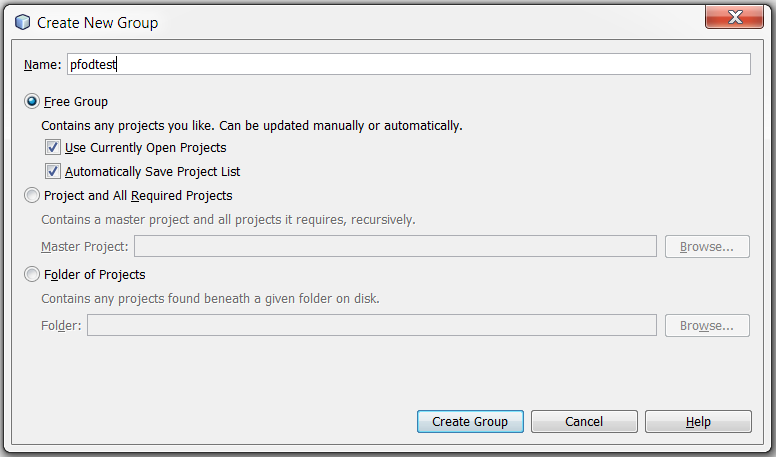
Unfortunately ALL Netbeans micro:bit projects are call bbc-microbit-classic-gcc, to you have to look at the source directory to see which one you are actually using. This is a problem when you go to re-open an existing project among many. You can avoid this problem by defining a new Project Group for each project.
Once you have imported your project into Netbeans, use File → Project Groups... to open the Manage Groups window.
Click New Group.. to create a new group and give it the name of your project. The ticked Use Currently Open Projects will ensure your current project is added to this new group.
Click Create Group to complete the process.
Then to switch between projects, use File → Project Groups... and in the Manage Groups window select/double click the project you want to work on. Then use File → Open Recent Project to open one and only the bbc-microbit-classic-gcc project in this group.
If you don't use Project Groups you will need to open the particular project manually. Navigate down to the code's build/bbc-microbit-classic-gcc subdirectory and open the netbeans project stored there.
Getting the Micro:bit Docs Offline
The source code and examples and doc for micro:bit C/C++ programming is available from lancaster-university github. The latest version of the microbit C/C++ docs is available from the Lancaster University microbit site.
You can download a zip file of the C++ docs from https://github.com/lancaster-university/microbit-docs and unzip this folder, microbis-docs-master. These docs are in .md files and so should be processed into webpages. For this you need to install (another) package, mkdocs (http://www.mkdocs.org/)
To install mkdocs, open a command prompt and run
pip install mkdocs
When that is finished, change directory to the microbis-docs-master directory (where the mkdocs.yml file is) and build the 'site' html files by running
mkdocs build
That will create a site sub-directory with the html doc files. Open the docs via the index.html file.
Loading Programs Onto Your Micro:bit
See Step 3 on https://www.microbit.co.uk/device/usb but note the file name below.
Flashing the application to the board
- The file you need to flash onto the mbed-enabled board is pfodtest-combined.hex
- Connect the board to your computer using a micro-USB cable.
- The board is shown as removable storage.
- From your file explorer, drag and drop the file onto the board.
The application is now on your board and should start working immediately. Note that some boards need a reset.
Serial Connection Via USB
The mbed serial port works by default on Mac and Linux, but Windows needs a driver. You can download the drive from here.
With your micro:bit usb plugged in, and no explorer drive windows open, run the installer:
It will take some time (especially on Vista), and pop up a few 'unsigned driver' warnings, but after a while you should have a Serial port. If the Serial port does not appear check out the 'Troubleshooting' section on this page.
Serial Communication with a PC provides information on setting up a terminal, TeraTerm for example, and some example serial programs. Note: the default USB Serial baud rate 115200, 8N1 (8 bits, No parity, 1 stop bit).
Note: The default buffer size is only 20 bytes (one bluetooth LE packet)
Troubleshooting
You can’t drag and drop more than one hex file at once onto your micro:bit. If you try to drag and drop a second hex file onto your micro:bit before the first file has finished downloading, then the second file may fail in different ways. When the first program has been written to the micro:bit, the drive will disengage. If you drag and drop a second file at this point it may not find the drive and the second write will fail. It may appear that there are two hex files on your BBC micro:bit so the micro:bit won’t be able to run multiple files.
To rectify this, unplug your micro:bit and plug it in again. Make sure that your micro:bit appears as MICROBIT and not MAINTENANCE.
If your micro:bit will not leave maintenance mode, then you may need to update or replace the firmware on the board, as described below.
Updating the micro:bit firmware
You normally won't need to do this.
To update your firmware you need to be in MAINTENANCE mode. You can enter MAINTENANCE mode by:-
- Unplug the USB cable from the micro:bit
- Hold down the micro:bit reset button
- While still holding down the reset button, plug the USB cable back in.
Your micro:bit will now show as a drive called MAINTENANCE instead. You can find the version in the 'version.txt' on the micro:bit.
If your micro:bit will not leave maintenance mode, then you may need to update or replace the firmware on the board by following these steps:
- Download the newest firmware from this page (currently version 0234 as of 7th July 2016)
- Unplug the micro:bit.
- Press and hold down the reset button next to the USB connector.
- The micro:bit will power on. Your computer's file browser will list it as a mass storage device called "MAINTENANCE".
- Copy the firmware hex file you downloaded in step 1 to the "MAINTENANCE" device.
- Wait until the drive dismounts and the system (orange) LED is flashing continuously.
- Unplug the micro:bit and plug in again, and the board should enumerate as a MICROBIT.